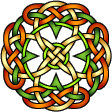|
This clan, recognised as such
by the Scottish Privy Council in 1 579 took its
name from the barony of Innes which lies between
the Spey and the Lossie in Morayshire. It was
granted to Berowald Flandrensis by Malcolm IV in
1160, and Berowald'
s grandson Sir Walter of
Innes received a charter of confirmation in 1225.
Since then their descendants have won
exceedingly varied distinction, and have proved
fertile in creating new branches. John, Bishop of
Moray from 1407 until 1414, was a son of Sir
Robert, 8th of Innes. It was he who rebuilt much
of Elgin Cathedral after it had been destroyed by
the Wolf of Badenoch, King Robert II'
s evil
son. William, 15th of Innes, attempted in 1554 to
murder Alexander Dunbar, Prior of neighbouring
Pluscarden, on the very altar steps of the same
cathedral, while the 16th baron sat in the
Parliament of 1560 which abolished the Catholic
Church in Scotland. It was left to later Inneses
to continue the tradition of the mediaeval
bishop. Outstanding among these were the two
brothers Lewis and Thomas, descendants of the
11th Baron. Father Lewis (1651-1738) was
appointed Principal of the Scots College at
Paris, where many of the mediaeval Scottish
records had been brought for safety during the
iconoclasm of the Reformation. He devoted himself
to the task of their preservation and
arrangement, with his brother'
s help; and
their collaboration also produced The Life of
James II, the exiled Catholic James VII of Scots.
At his court of Saint Germains Father Lewis acted
as a confidential secretary besides holding the
posts of Lord Almoner to the Chevalier and
Secretary of State for Scotland in 1690. His
brother, Father Thomas Innes (1662-1744), had
been born in Aboyne parish, and after helping
Lewis to arrange the church records of Glasgow at
the Scots College he returned to his country to
work as a priest of the Scottish Mission. In 1701
he returned to Paris, where he died. The immense
services of these brothers to the history of
Scotland is commemorated today by The Innes
Review. Meanwhile it was left to a clansman of a
very different complexion to continue the
tradition. Cosmo Innes (1798-1874) descended from
the hereditary Keepers of Spynie Castle. He held
Whig views, pursued a successful career as an
advocate, and became Sheriff of Moray in 1840.
But his passion was to rescue Scotland'
s
historical documents. He devoted immense labours
to arranging, editing and publishing h his
country'
s records, and became a professor of
Edinburgh University In the sphere of public life,
Sir James, 12th of Innes, was chief esquire to
James Ill and entertained that very mobile
monarch James IV at Innes Castle in 1490. During
the troubled times that followed the deposition
of Mary, Queen of Scots, the 16th Baron was so
unlucky as to be beheaded by one of the Regents
(most of whom suffered a similar fate). The 19th
Baron shared the interest of James VI in
witchcraft, and was alleged to have entertained
the Queen of Elphin. But he also had the
practical sense to establish the port of Garmouth
in the Moray Firth, and it was here that Sir
Robert, 20th of Innes, welcomed Charles II in
1650 when he arrived to claim his kingdoms from
Cromwell. As a reward Innes was made a baronet;
and it was the 6th baronet who succeeded as Duke
of Roxburghe in 1805. His descendant is the 29th
Baron of Innes.
Of the many cadet branches,
there are those who descend from William, second
son of the 11th Baron. William'
s son was
made hereditary Constable of Redcastle, whose
ruins still stand beside the Beauly Firth. There
Constable Robert Innes gave his support to Mary,
Queen of Scots, was betrayed by his own son, and
murdered in the castle. Nemesis struck in 1595
when his son was beheaded in turn for his part in
the murder of the Bonnie Earl of Moray. Such were
the antecedents of the 1st baronet of this
branch, who built the magnificent castle of
Balveny on Speyside, and whose family still
flourish in Banffshire although they lost all for
Charles I, and were out for the Young Pretender
in 1745.
|



